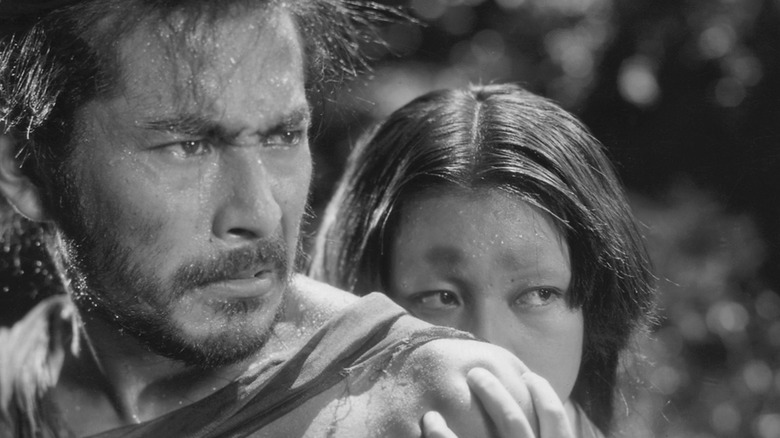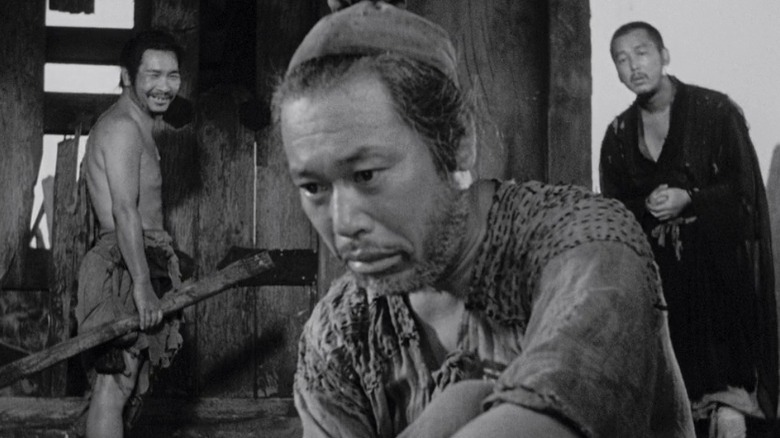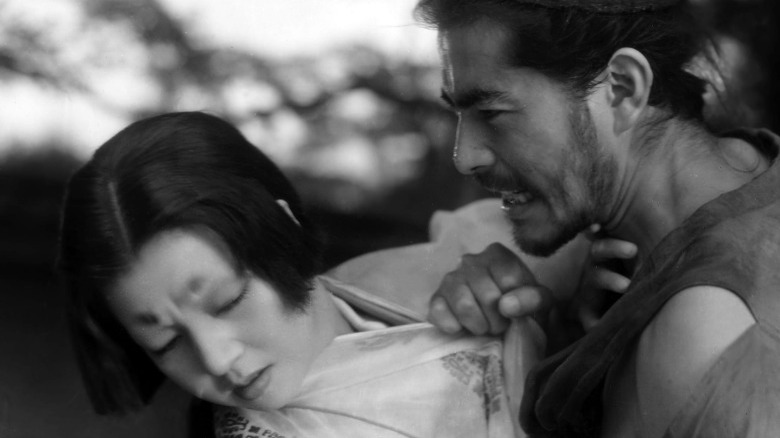Rashomon Ending Explained: The Truth Is Often Mutable And Ambivalent
The ruined gate of Rashōmon in Kyoto, which acts as the central setting in Ryūnosuke Akutagawa's short story "Rashōmon," had an unsavory reputation during the 12th century. A frequent hideout for thieves and hooligans, the Rashōmon gate came to be known as a symbol of moral degradation, which Akutagawa incorporated in his short to great effect. When filmmaker Akira Kurosawa wove together aspects of two Akutagawa shorts — "Rashōmon" and "In A Grove" — in his 1950 Jidaigeki drama "Rashomon," he transformed the ruined gate into a site of subjective retelling, a sort of moral crossroads where despair and hope coexist. Kurosawa opens "Rashomon" with three men seeking shelter from torrential rain under the ruined gate, which leads to the recounting of a murder mystery with no definite ending. Four eyewitnesses recall a singular incident in the forest in wildly different ways, making the truth impossible to arrive at. What does this all mean?
Kurosawa's "Rashomon" is considered one of the greatest films ever made for good reason. Taking the trope of the unreliable narrator to the extreme, Kurosawa dissects the follies of human nature with this simple story that unravels in a labyrinthine manner — a story that refuses to fit into interpretative boxes. The appeal of this Heian-era tale lies in the destabilization of the narrative structure, the stunning interplay of light and dark (courtesy of cinematographer Kazuo Miyagawa), and the dizzying, open-ended nature of its ending. While "Rashomon" is not as layered as Kurosawa's "Throne of Blood," or his visually surreal "Dreams," the film paints a riveting portrait of his deep understanding of human nature, and how cinema amplifies these aspects of life.
Let's take a stab at reconstructing the truth in a tale where lies dominate and color our perception of what really happened.
The Rashomon Effect
The events that take place over the course of "Rashomon" are fairly easy to parse. A woodcutter (Takashi Shimura) recounts a sordid tale of murder and sexual assault to a priest (Minoru Chiaki) and a commoner (Kichijiro Ueda), who are perplexed by the elusive nature of the truth. A samurai (Masayuki Mori) and his wife (Machiko Kyō) are involved, who are targeted by a notorious bandit (Toshirô Mifune), who is either a murderer or assaulter (or both) in various versions of the story. By the end of this unfortunate affair, the samurai is dead, leaving the wife and the bandit to appear in court and provide their testimonies. The third witness is none other than the dead samurai himself, who recounts his version of the truth via a Shinto psychic. The results are baffling, and as for the verdict — there isn't one.
Kurosawa's decision to not provide us with a verdict, or a glimpse into the decision-makers in the courtroom, directly creates space for the audience to arrive at their own conclusions. While all works of fiction that are rich in subtext inevitability usher in interpretative analysis, "Rashomon" actively invites audiences to engage with the dynamic tale woven in deception and half-truths. The three witnesses look directly at the camera and plead their case, revealing their clumsily-hidden follies in the process. People lie for various reasons, to the point that they start believing in these self-fabrications themselves — "Rashomon" exemplifies this human instinct to falsify reality to suit one's interests, sometimes even from beyond the grave.
In Kurosawa's world, there is no objective truth, as every memory, recollection, and proclamation of the truth, is a tweaked, bastardized version of an incident. Life itself is governed by The Rashomon Effect, where individual perception and recollection paint our everyday realities.
There is no truth, only different versions of it
The woodcutter begins the story by noting that he had stumbled upon an amulet, and then goes on to recount a seemingly unbiased version of the entire incident. However, the commoner, who provides philosophical depth to the conversation throughout the film, manages to coax the truth out of the woodcutter: he had personally witnessed everything but decided not to testify in order to not get into trouble. The woodcutter provides a fourth version of the tale, which might have the most merit, given how he's completely removed from the involved parties. However, his account does not remain untainted, as his initial omission of involvement is fueled by blatant self-preservation.
The three men, who serve as a chorus for the central events, are by no means unbiased or possess a preternatural awareness of what really happened. However, their presence under the ruined gate is a gateway to the heart of the story: the forest, which becomes the site of death, violence, control, and passion, perennially alive with palpable anxiety. Kurosawa cuts back and forth between these two locales, while momentarily lingering on a sparse courtyard in the courtroom scenes. These electrifying snippets come together to create a puzzle that cannot be solved, for the truth is unknowable, and human beings are incapable of being completely honest with themselves.
Perhaps the samurai did kill himself, or maybe he was murdered by the bandit, either during a duel or a sudden crime of passion. The point is, we do not know, as all of these versions simultaneously exist. After all, recollections are performances, dramatic and embellished. If unfiltered, honest recollection is an impossibility, can there even be one uncontestable version of what really happened? The answer, unfortunately, will always be colored by your perception.


